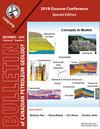Stratigraphy of the Middle Devonian Keg River and Prairie Evaporite formations, northeast Alberta, Canada
Q3 Earth and Planetary Sciences
引用次数: 2
Abstract
Northeast Alberta is the location of one of the world’s largest petroleum deposits, the Athabasca Oil Sands, hosted in Lower Cretaceous McMurray Formation sandstones. The McMurray Formation was deposited on a deeply eroded Upper Devonian unconformity surface that was strongly influenced by underlying carbonate and evaporite units. Development of the oil sands has resulted in a significant increase in new data related to the underlying Devonian of northeast Alberta. In particular, the requirement for deep disposal of water has resulted in a number of wells being drilled into and through the porous dolomites of the Middle Devonian Keg River Formation that is a few hundred metres below the McMurray bitumen deposits. In addition, the acquisition of large areas of high-resolution 3D seismic data to assist the delineation and development of the oil sands reserves has provided powerful insights into the depositional patterns and later dissolutive geometries of the underlying carbonate and evaporite deposits. The Keg River and overlying Prairie Evaporite formations that are the focus of this paper were deposited in the intracratonic Elk Point Basin that covered most of the area now delineated by the Western Canada Sedimentary Basin. These units and their lateral equivalents have been extensively studied in Saskatchewan, northwest Alberta, southern Northwest Territories and northeast British Columbia. In contrast, the two formations have been lightly studied and rarely published upon in northeast Alberta. The current detailed study of several areas with abundant new data, combined with a review of the regional dataset in northeast Alberta has provided new insights into the geology of these units. A revised stratigraphy for the two formations is presented which includes the formal definition of the proposed Aurora Member, a significant anhydrite unit within the Prairie Evaporite Formation that was previously included as a sub-unit of the Whitkow Member. The Keg River Formation is divided into the Lower and Upper Keg River members. The Lower Keg River Member is a thin, regionally consistent unit composed of an upward deepening transgressive systems tract. In most places, the Lower Keg River is overlain by the Upper Keg River Member which has two distinct facies. At the base is a widespread shallowing upwards microbial oncolitic facies, here referred to as the Keg River Ramp, which provided the foundation for more aerially restricted overlying deposits of shallow water carbonate. On the edge of the basin, a Basin Margin Platform formed and prograded out over the Keg River Ramp. In the centre of the basin, biogenic build-ups developed. Integrated interpretation of the seismic with the wells shows that the build-ups often have well established but aerially restricted reef margins of frame-building organisms. However, the bulk of these build-ups consist of loosely consolidated peloidal grainstones and packstones. A drop in sea level in conjunction with the development of a continuous barrier reef trend, the Presqu’ile Barrier, across the mouth of the Elk Point Basin caused restriction of the basin resulting in widespread laminites forming at the transitional contact between the Keg River and overlying Prairie Evaporite formations. As sea-level continued to drop, evaporitic drawdown converted the Elk Point Basin into a vast inland saline sea with an exposed marginal platform and emergent carbonate build-ups. The Prairie Evaporite Formation deposits of dolomite, anhydrite, gypsum, halite and potash were deposited in and around this sea. During this evaporitic phase almost all of the underlying Keg River limestone was converted to dolomite. The dolomitization resulted in the development of excellent porosity in most of the Keg River strata. The Prairie Evaporite is divided into two major brining upward cycles of deposition. The lower Prairie Evaporite cycle began with anhydrite and gypsum deposits forming adjacent to the exposed Keg River build-ups. These anhydrite units have been recognized and described in other parts of the Elk Point Basin but have never been formally defined stratigraphically. The paper provides detailed description and stratigraphic definition for this unit as the proposed Aurora Member. In the deeper parts of the basins between the reefs, evaporitic laminites accumulated. Eventually, the brines became supersaline and the remaining topography between the reefs was filled up with the Whitkow Member which consists mainly of halite. The upper Prairie Evaporite brining upward cycle began when a renewed rise in sea-level breached the Presqu’ile Barrier and allowed mesohaline brine to flood back across the basin. Continuing sea-level rise allowed reef growth to re-establish on top of the barrier which again led to restricted marine water flow into the basin. The vertical aggradation of the Presqu’ile Barrier as sea-level rose provided the accommodation space for the upper Prairie Evaporite cycle. The anhydrite portion of the cycle is represented by the widespread Shell Lake Member which transitions upward into the Leofnard Member which is composed predominantly of halite. In northeast Alberta, the Prairie Evaporite is capped by a thin clastic unit and the cycle of deposition is terminated by a significant unconformity at the base of the Watt Mountain Formation.加拿大亚伯达省东北部中泥盆世桶河和草原蒸发岩地层
阿尔伯塔省东北部是世界上最大的石油矿床之一阿萨巴斯卡油砂的所在地,该油砂产于下白垩纪的McMurray组砂岩中。McMurray组沉积在深受下伏碳酸盐岩和蒸发岩单元影响的上泥盆纪不整合面上。油砂的开发使阿尔伯塔省东北部下伏泥盆纪的新数据显著增加。特别是,由于需要对水进行深度处理,因此在McMurray沥青矿床下方几百米的中泥盆纪Keg河组的多孔白云石中钻出了多口井。此外,获取大面积高分辨率三维地震数据以协助划定和开发油砂储量,为深入了解下伏碳酸盐岩和蒸发岩矿床的沉积模式和后来的溶解几何结构提供了有力的见解。Keg河和上覆的草原蒸发岩地层是本文的重点,它们沉积在克拉通期内的Elk Point盆地中,该盆地覆盖了加拿大西部沉积盆地现在划定的大部分区域。萨斯喀彻温省、阿尔伯塔省西北部、西北地区南部和不列颠哥伦比亚省东北部对这些单元及其横向等效物进行了广泛研究。相比之下,阿尔伯塔省东北部对这两个地层的研究很少,也很少发表文章。目前对具有丰富新数据的几个地区的详细研究,结合对阿尔伯塔省东北部区域数据集的审查,为这些单元的地质提供了新的见解。介绍了两个地层的修订地层学,其中包括拟议Aurora段的正式定义,Aurora是Prairie Evaporite地层中的一个重要硬石膏单元,以前曾被列为Whitkow段的一个子单元。Keg河组分为Keg河下段和Keg河上段。Keg河下游河段是一个薄的、区域一致的单元,由向上加深的海侵体系域组成。在大多数地方,Keg河下游被Keg河上游段覆盖,该段有两个不同的相。底部是一个广泛的向上变浅的微生物oncolitic相,这里被称为Keg河斜坡,它为更受空中限制的浅水碳酸盐岩上覆沉积物提供了基础。在盆地边缘,形成了盆地边缘平台,并在Keg河斜坡上前进。在盆地的中心,形成了生物堆积。地震和油井的综合解释表明,这些堆积物通常具有良好的结构,但在空中受到限制的框架构建生物的礁缘。然而,这些堆积物大部分由松散固结的似球粒粒状灰岩和泥粒灰岩组成。海平面的下降,加上埃尔克角盆地河口持续的堡礁趋势,即Presqu’ile屏障的发展,导致盆地受到限制,导致在Keg河和上覆草原蒸发岩地层之间的过渡接触处形成了广泛的层积岩。随着海平面的持续下降,蒸发性的下降将埃尔克角盆地变成了一片广阔的内陆盐水海,有一个裸露的边缘平台和涌现的碳酸盐堆积。该海域及其周围沉积了由白云石、硬石膏、石膏、岩盐和钾盐组成的草原蒸发岩组矿床。在蒸发期,几乎所有Keg河下伏的石灰岩都转化为白云石。白云石化作用导致大部分Keg河地层形成了良好的孔隙度。草原蒸发岩分为两个主要的向上卤水沉积循环。下草原蒸发岩旋回始于暴露的Keg河堆积物附近形成的硬石膏和石膏矿床。这些硬石膏单元已在Elk Point盆地的其他部分得到认可和描述,但从未在地层上进行过正式定义。本文对该单元作为拟建Aurora段进行了详细描述和地层定义。在珊瑚礁之间的盆地深处,蒸发层积岩堆积。最终,盐水变成了超盐,珊瑚礁之间剩余的地形被主要由岩盐组成的惠特科夫段填满。当海平面再次上升突破普雷斯奎尔屏障,并允许中盐盐水流回盆地时,上草原蒸发岩盐水上升周期开始了。海平面的持续上升使珊瑚礁在屏障顶部重新生长,这再次导致流入盆地的海水受到限制。随着海平面上升,Presqu’ile屏障的垂直沉积为上草原蒸发岩旋回提供了容纳空间。
本文章由计算机程序翻译,如有差异,请以英文原文为准。
求助全文
约1分钟内获得全文
求助全文
来源期刊

Bullentin of Canadian Petroleum Geology
Earth and Planetary Sciences-Geochemistry and Petrology
CiteScore
2.50
自引率
0.00%
发文量
0
期刊介绍:
The Bulletin of Canadian Petroleum Geology is a peer-reviewed scientific journal published four times a year. Founded in 1953, the BCPG aims to be the journal of record for papers dealing with all aspects of petroleum geology, broadly conceived, with a particularly (though not exclusively) Canadian focus. International submissions are encouraged, especially where a connection can be made to Canadian examples.
 求助内容:
求助内容: 应助结果提醒方式:
应助结果提醒方式:


